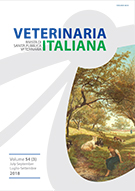The prevalence of non-O157:H7 Shiga toxin-producing Escherichia coli (STEC) in Namibian game meat
DOI:
https://doi.org/10.12834/VetIt.1228.6844.3Abstract
Large game animals play an important role as carriers and transmitters of O157:H7 and non-O157:H7 Shiga toxin-producing Escherichia coli (STEC) in nature. Fresh meat obtained from game animals has been identified as an important source of food-borne STEC infections. The aim of this study was to evaluate the incidence of the top 6 non-O157 STEC strains (serogroups O26, O45, O103, O111, O121, and O145) in Namibian game meat based on testing for stx, eae, and O-group-specific genes. Meat samples from gemsboks (Oryx gazella) (n = 75), springboks (Antidorcas marsupialis) (n = 41), greater kudus (Tragelaphus strepsiceros) (n = 5), and wildebeests (Connochaetes taurinus) (n = 5) were collected from 2 Namibian abattoirs and tested for STEC using real-time PCR techniques. Both Shiga toxin (stx) and intimin (eae) virulence genes were detected in 94 out of 126 samples (74.6%). Five of the top 6 STEC serogroup-specific genes were also detected in samples that were positive for both the stx and eae genes. The results of this study show a high incidence of non-O157 STEC O-group genes in Namibian game meat, which suggests that further scrutiny and testing may be necessary to avoid foodborne outbreaks.






